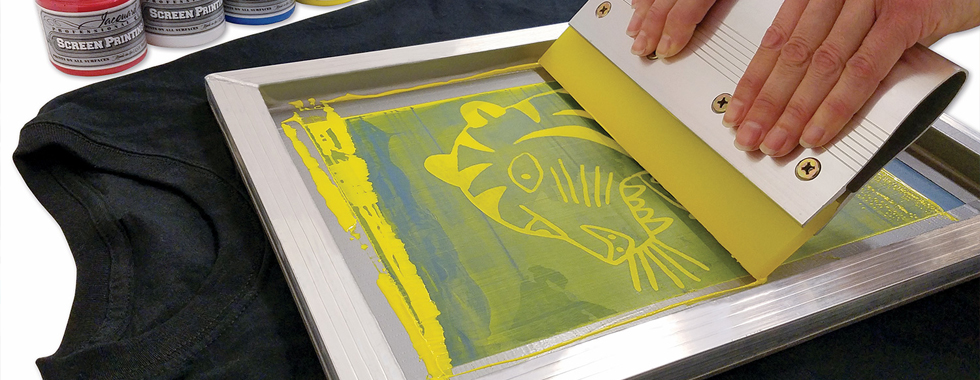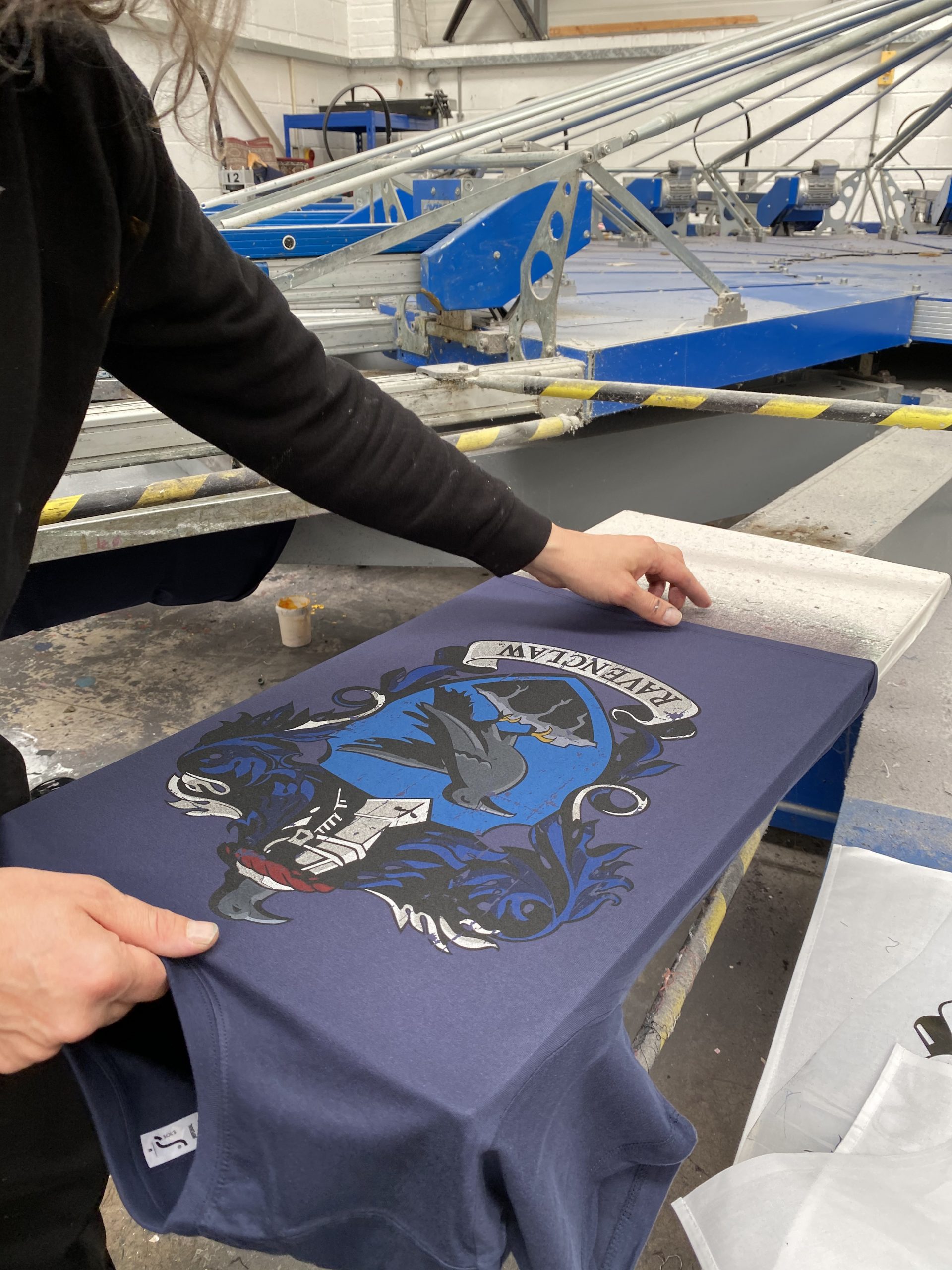ChatGPT said: How 10:9 Design Screen Printing can elevate your event presence
Wiki Article
Discover the Various Sorts Of Screen Printing Techniques for Your Next Job
Screen printing uses a varied range of strategies that can improve any creative job. From typical techniques like serigraphy to modern-day advancements such as direct-to-garment printing, each strategy has its unique benefits. Specialized options, including metallic and eco-friendly inks, introduce also more possibilities. Understanding these methods can significantly affect the last outcome. Nevertheless, the obstacle lies in selecting one of the most suitable method for specific requirements and preferred impacts. What factors should one take into consideration?
The Fundamentals of Screen Printing
Screen printing may appear facility, it is basically a simple procedure that involves moving ink through a mesh screen onto different surfaces. The method starts with the creation of a pattern, which specifies the layout to be published. This stencil is attached to a mesh screen, usually constructed from polyester or nylon. As soon as the stencil is in location, ink is related to the screen and pressed through the mesh using a squeegee, leading to the preferred pattern being published on the underlying product.Screen printing can be performed on a variety of substrates, consisting of paper, plastic, and fabric, making it a versatile selection for different jobs. The procedure enables vibrant colors and complex designs, making it popular in industries such as marketing, style, and art. Comprehending these essentials gears up people with the fundamental understanding needed to check out even more innovative techniques in screen printing.
Typical Screen Printing Techniques
Standard screen printing techniques have actually been utilized for centuries, protecting the craftsmanship and virtuosity of this approach. This strategy makes use of a mesh screen to move ink onto a substrate, such as material or paper, permitting for dynamic and resilient layouts. The procedure begins with creating a pattern, which obstructs particular areas of the screen to control where the ink will be applied.One prominent strategy is serigraphy, often used for artistic prints and limited versions. Another is making use of water-based inks, which are green and provide a soft feeling on textiles - 10:9 Design Abilene. Additionally, conventional techniques can consist of hands-on printing, where craftsmens use ink with a squeegee, guaranteeing precision and attention to information
These techniques stay valued in the market for their responsive quality and the unique appearances they create, attracting both customers and creators who appreciate the heritage of screen printing.
Digital Screen Printing Innovations
As the need for faster production and customization in the printing sector has actually risen, digital screen printing advancements have actually become a game-changer. This innovation blends conventional screen printing techniques with electronic procedures, enabling rapid prototyping and elaborate layouts that were formerly hard to attain. One significant development is the introduction of direct-to-garment (DTG) printing, which assists in top quality, full-color prints on numerous textiles without the requirement for displays. Furthermore, advancements in ink formulations have actually caused environment-friendly options that preserve vivid shades while decreasing environmental effect. The usage of automated systems better enhances manufacturing, decreasing labor expenses and boosting precision. These developments not just accommodate tiny batch orders and personalized styles yet also permit quicker turn-around times, making them ideal for services concentrated on conference consumer demands in a hectic market. Digital screen printing, as a result, stands for a vital advancement in the domain name of printing techniques.Specialized Screen Printing Approaches
Discovering specialized screen printing approaches reveals a varied range of strategies that press the boundaries of creative thinking and functionality in the printing industry. Among these, glow-in-the-dark inks offer a special visual result, making layouts come active in low-light problems. Metal inks, understood for their glittering coating, include a touch of deluxe to published products. An additional innovative method is discharge printing, which removes dye from the fabric as opposed to adding ink, leading to a soft, classic feel. High-density printing creates a raised texture externally, enhancing responsive interaction. Furthermore, water-based inks are gaining appeal for their vibrant colors and decreased ecological influence. Each of these specialty techniques deals with particular style requirements, making it possible for brand names and artists to produce standout products that resonate with their audiences. By leveraging these approaches, companies can raise their screen printing projects to new elevations, making sure memorable perceptions.Eco-Friendly Screen Printing Options
Environment-friendly screen printing alternatives are getting traction as the sector shifts in the direction of sustainability. Lasting ink choices and the use of naturally degradable materials are key components in reducing the ecological impact of the printing process. By adopting these techniques, screen printers can contribute to a more lasting future while preserving high-grade outcomes.Lasting Ink Options

Biodegradable Products Usage
As the screen printing market advances, the unification of biodegradable materials is coming to be significantly essential for ecologically conscious techniques. Suppliers and designers are now discovering inks and substratums made from all-natural, renewable energies that disintegrate a lot more successfully than traditional counterparts. These eco-friendly options minimize plastic waste and decrease ecological effect, aligning with the growing need for sustainable products.
Common examples consist of water-based inks and organic cotton fabrics, both of which decrease dangerous chemicals and promote eco-friendliness. Brand names that take on these products frequently boost their market allure, bring in consumers who prioritize sustainability. As recognition of ecological issues remains to rise, the shift towards eco-friendly materials in screen printing is most likely to gain energy, promoting a greener market standard.
Selecting the Right Technique for Your Project
Exactly how can one figure out one of the most appropriate screen printing method for a specific project? The choice depends upon a number of aspects, consisting of the product to be published on, the intricacy of the layout, and the preferred production volume - 10:9 Design Abilene. As an example, direct-to-garment printing is perfect for detailed layouts with numerous shades, while conventional screen printing excels for bigger runs of less complex graphics
Furthermore, factor to consider of the end-use of the published product is vital. For outside applications, strategies that offer resilience and weather condition resistance, such as plastisol ink, might be preferred. On the other hand, environmentally-conscious tasks might gain from biodegradable products or water-based inks.
Ultimately, comprehending the job's one-of-a-kind demands enables an enlightened selection, making certain both aesthetic appeal and useful longevity. By evaluating style complexity, product compatibility, and manufacturing range, one can effectively choose the most suitable screen printing technique to meet their job's objectives.
Regularly Asked Concerns
What Is the Background of Screen Printing?
Screen printing stemmed in old China around 1000 AD, advancing via Japan and Europe. By the 20th century, it ended up being preferred in industrial art and fashion, changing exactly how styles were generated and dispersed globally.
How Do I Prepare Art Work for Screen Printing?
To prepare art work for screen printing, one have to assure high resolution, use an appropriate color mode, develop separate layers for each color, and transform text to describes, assuring compatibility with the printing process and preferred end result.What Products Are Best for Screen Printing?
The most effective materials for screen printing consist of top notch inks, resilient displays, and appropriate substratums like cotton, polyester, or blends. In addition, using proper emulsion and mops can improve the printing procedure and outcomes.Can I Screen Publish in your home?
Yes, screen printing at home is feasible. With the appropriate products, arrangement, and techniques, individuals can produce premium prints. Mindful factor to consider of work area and devices is vital for successful outcomes.What Are Typical Errors in Screen Printing?
Typical blunders in screen printing include incorrect exposure times, insufficient ink uniformity, imbalance of screens, not enough cleaning of materials, and neglecting to check prints. These errors can jeopardize the high quality and accuracy of the end product.Screen printing might seem complicated, it is basically a simple process that includes moving ink with a mesh screen onto numerous surfaces. As the demand for faster production and modification in the printing industry has actually risen, electronic screen printing technologies have arised as a game-changer. Discovering specialized screen printing techniques discloses a varied array of techniques that press the boundaries of creativity and performance in the printing industry. The best materials for screen printing consist of high-quality inks, resilient displays, and ideal substrates like cotton, polyester, or blends (10:9 Design near me). Usual errors in screen printing consist of inappropriate direct exposure times, inadequate ink consistency, misalignment of screens, not enough cleansing of materials, and disregarding to examine prints
Report this wiki page